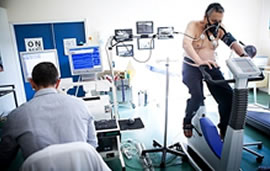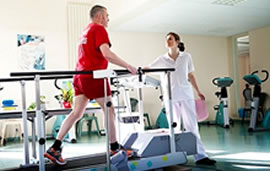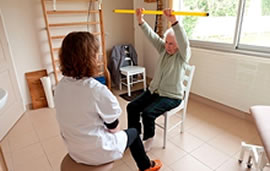We are selling items! Kindly VISIT our STORE page and GET YOURS Now!
Success Stories
Cardiac Rehab: Case 1
A very successful accountant, 36 years old Mr. F., was diagnosed with ischemic/coronary heart disease. His stress EKG showed significant S-T segment changes and was referred to an invasive cardiac procedure. When our cardiac rehabilitative services were suggested to him, he gladly accepted them. After one month, he repeated the same stress EKG with the same cardiologist and the previously significant S-T segment changes were now insignificant. The cardiac procedure referral was retracted. If you knowsomeone who suffers from ischemic or coronary heart disease, refer him to us before trying other possibly invasive procedures. We can help.
Pulmonary Rehab
A well to do, 58 year old man, Mr. W., was on a minimum of 6 liters of oxygen per minute and hooked up to two oxygen concentrators. He had been diagnosed with interstitial pulmonary fibrosis. He complained of severe shortness of breath. He was buying the newest medications as soon as they came out. I suggested to his pulmonologist to try pulmonary rehabilitation. He replied that the Mr. KW’s case was hopeless, deteriorating, and was only a matter of time before he passed away. Mr. KW, however, was willing to try anything with any chance of help. He told me that he had been confined to his wheel chair for years. On his first evaluation, he could barely walk to for 30 seconds while being on the 6 liters of supplemental oxygen. At about 27 seconds of walking, his blood oxygen saturation was severely reduced and he could no longer continue. After 90 days of our rehabilitative treatment, Mr. KW was able to walk on the beach for 90 minute continuously without any supplemental oxygen, medication, or loss of blood oxygen saturation. He was back to living a normal life.
If you know someone who is suffering from shortness of breath, COPD, sarcoidoses, pulmonary fibrosis, or a need for supplemental oxygen, don’t leave them to suffer: refer them to us, we can help.
image retrieved from:
http://sandiegospeedboats.com/heres-why-you-need-to-walk-on-the-beach
Cardiac Rehab: Case 2
A 60 year old, Mr. K., was confined to a wheelchair due to congestive heart failure. His echo cardiography showed that his ejection fraction was only 8%. His abdomen and both his legs were swollen and multiple lacerations and oozing ulcers all over his legs. This was due to the backward pressure on the heart. He was also on supplemental oxygen. Other rehbailitation professionals were afraid of treating him because he could have died under their care. Our rehab provider determined that Mr. G. could benefit from our servives. When consulting with Mr. G’s MD, he had referred to Mr. G as a time bomb waiting to explode. Within 2 months of starting with our provider, however, Mr. G was walking and no longer in need of supplemental oxygen. Within 3 months of starting rehab, all his swellings were gone, he was back to living a normal life. He was even able to go to the gym and do moderate to heavy exercise for over an hour. Mr. G, is no longer in need of therapy. He is going to repeat his echo cardiography and we expect an immense improvement based on his functionality, stay tuned for the ejection fraction percentage.
If you know someone who suffers from ischemic or coronary heart disease, refer him to us before trying other possibly invasive procedures. We can help.
image retrieved from:
http://healthlineinfo.com/wp-content/uploads/2012/11/heart_failure.jpg
Pain Management
Ms. L, a 68 year old, was confined to bed due to severe pain in her right leg. She was diagnosed with chronic regional pain syndrome couldn’t move her leg or turn in bed due to the severe pain. This was all despite being on injectable morphine. Other professionals couldn’t get her out of bed because of the pain. Within a few days under our care, she was able to move her right leg, actively get out of bed, walk with a rollator, and no longer needed any of her pain medications.
If you know someone who is in a similar situation, refer them to us.
image retrieved from:
http://images.sciencedaily.com/2012/02/120222093506-large.jpg























 Youtube
Youtube Facebook
Facebook Twitter
Twitter.fw.png)